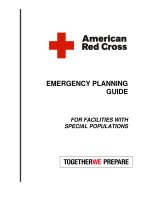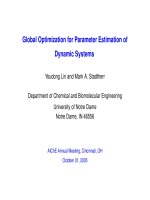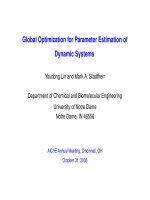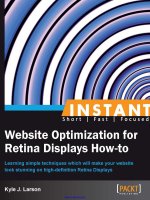Process planning optimization for five axis sculptured surfaces finishing
Bạn đang xem bản rút gọn của tài liệu. Xem và tải ngay bản đầy đủ của tài liệu tại đây (3.07 MB, 177 trang )
Founded 1905
PROCESS PLANNING OPTIMIZATION FOR FIVE-AXIS
SCULPTURED SURFACES FINISHING
LI HAIYAN
(B.Eng., M.Eng.)
A THESIS SUBMITTED
FOR THE DEGREE OF DOCTOR OF PHILOSOPHY
DEPARTMENT OF MECHANICAL ENGINEERING
NATIONAL UNIVERSITY OF SINGAPORE
2012
I
ACKNOWLEDGEMENTS
First and foremost, I would like to express my sincere gratitude and
appreciation to my supervisor, A/Prof. ZHANG Yunfeng, from the Department of
Mechanical Engineering in National University of Singapore, for his invaluable
guidance, advice and discussion throughout the entire duration of this project. It has
been a rewarding research experience under his supervision.
I would also like to show my appreciation for the financial support in the form
of research scholarship from the National University of Singapore.
Special thanks are given to Dr. LI Lingling for her guidance and suggestions,
and GENG Lin for his assistance of this research. I also wish to thank all my other
fellow students for their support and a pleasant research environment. Besides, I wish
to give my thanks to all my other friends, SHI Min, WANG Xue, etc. for their
continuously encouragement.
Finally, I thank my family for their kindness and love. Without their deep love
and constant support, I would not have completed the study.
II
TABLE OF CONTENTS
ACKNOWLEDGEMENTS I
TABLE OF CONTENTS II
SUMMARY VII
LIST OF TABLES IX
LIST OF FIGURES X
LIST OF GLOSSARY XIII
Symbols XIII
Abbreviations XIV
CHAPTER 1 INTRODUCTION 1
1.1 Five-axis Sculptured Surface Machining 1
1.2 Single Cutter Machining vs. Multi-Cutter Set Machining 4
1.3 Process Planning for 5-axis Sculptured Surface Machining 5
1.3.1 Cutter selection 6
1.3.2 Tool path generation 7
1.3.3 Integrated process planning 9
1.4 Research Motivation 10
1.5 Objectives and Scope of the Study 12
III
1.6 Outline of the Thesis 13
CHAPTER 2 A-MAP CONSTRUCTION AND ITS
IMPROVEMENT 14
2.1 Background 14
2.2 Profile Tolerance in A-map Calculation 17
2.3 Analysis on Part Surfaces in A-map Calculation 19
2.3.1 Analysis on part surface for LG checking 19
2.3.2 Analysis on part surface for RG checking 20
2.3.3 Analysis on part surface for GC checking 22
2.3.4 Summary on analysis of part surfaces in interference checking 22
2.4 The Improved A-map Construction Algorithm 23
2.4.1 Accessible range for LG avoidance 25
2.4.2 Accessible range for RG avoidance 27
2.4.3 Accessible range for GC avoidance 29
2.4.4 The overall search algorithm 31
2.5 Comparison Study 33
2.6 Summary 36
CHAPTER 3 A-MAP APPLICATION FOR 5-AXIS MULTI-
CUTTER SELECTION 38
3.1 Background 38
3.2 Identification of Feasible Cutters 42
3.3 Cutting Region Allocation for a Feasible Cutter 43
3.3.1 Boundary tracing 44
IV
3.3.2 Cutting region identification 50
3.4 Effective Cutting Region Identification in Multi-Cutter Set 52
3.5 Construction of Candidate Multi-Cutter Sets 54
3.6 Obtain the Optimal Cutter Set 56
3.6.1 Machining strip width estimation 57
3.6.2 Output the optimal cutter set 60
3.7 The Overall Algorithm 60
3.8 Examples and Discussions 61
3.8.1 Case study 1: a benchmark part 62
3.8.2 Case study 2: a general example 66
3.9 Summary 67
CHAPTER 4 A-MAP APPLICATION FOR OPTIMAL 5-AXIS
CUTTER LOCATION (CL) PATH GENERATION 69
4.1 Background 70
4.2 Overview of the Proposed Optimal CL-Path Generation Method 76
4.3 Optimal Cutter Posture Selection along a Cutting Direction 78
4.3.1 Optimal cutter posture selection from the A-map 78
4.3.2 Optimal cutter posture selection through an interpolation approach 80
4.4 Optimal Cutting Direction Selection 81
4.5 CL Data Generation with Smooth Posture Change on a Path 85
4.5.1 Calculation of the maximum allowable step-forward length 86
4.5.2 Generate the CL data at the next CC point 88
4.6 Step-Over Calculation 91
4.7 The Overall Algorithm for CL-Path Generation 94
V
4.8 A Comparison Case Study 96
4.9 Summary 99
CHAPTER 5 MULTI-CUTTER MACHINING: CL PATH
GENERATION, SYSTEM IMPLEMENTATION, AND TESTING
101
5.1 Background 102
5.2 Iso-Planar CL Paths Generation in Multi-Cutter Machining 102
5.2.1 Optimal cutting direction selection 104
5.2.2 CL data generation 106
5.2.3 Case study on multi-cutter CL path generation 110
5.3 An Integrated Process Planning System for Multi-Cutter 5-axis Machining 111
5.3.1 The main interface 112
5.3.2 The input to the system 113
5.3.3 Display of a cutter with a specified posture at a surface point 115
5.3.4 Optimal multi-cutter set selection 117
5.3.5 Multi-cutter CL path generation 118
CHAPTER 6 CONCULUSION AND FUTURE WORK 123
6.1 Conclusions 123
6.2 Future Work 126
REFERENCES 128
APPENDIX A SURFACE WITH STOCK DATA A-1
VI
APPENDIX B PART OF CL DATA FOR MULTI-CUTTER
MACHINING IN VERICUT B-1
VII
SUMMARY
This thesis presents the study on the process planning optimization problem
for 5-axis finish-cut milling of sculptured surfaces with multi-cutters. The process
planning issues addressed include multi-cutter selection and tool-path (cutter location
or CL path) generation. In both decision-making processes, maximizing machining
efficiency is a common optimization objective. This is also an extension of our
previous study on optimal single cutter selection and tool-path generation for 5-axis
finish milling of sculptured surfaces. To this end, research work has been carried out
in the following aspects.
Firstly, the accessibility range (cutter posture range that is free of interferences)
of a cutter to a point on a given surface provides the complete set of information for
cutter selection and CL generation. In our previous study, an algorithm was developed
to obtain the accessibility map (A-map) of a cutter to a point based on the nominal
surface (design surface). In this study, the effects of surface tolerance and stock
surface are considered and incorporated into the A-map evaluation algorithm, making
the A-map information more accurate.
Secondly, for a partially-accessible cutter to a surface, the cutter is only
accessible to some portions of the surface, which is called the cutting regions of the
cutter. In multi-cutter selection, the identification of cutting regions for every
partially-accessible cutter is essential for cutting area assignment to different cutters.
In this study, a “boundary tracing” algorithm has been developed for identifying the
boundaries of all the cutting regions of a cutter. Measures are also taken to further
VIII
refining the boundaries such that (1) the points on the boundaries are interference-free,
(2) the boundaries become smoother, and (3) the cutting region is sufficiently large.
With this cutter/cutting regions information, for a given multi-cutter set, an algorithm
has been developed to assign the whole surface to each cutter so that a cutter in the set
has its own effective cutting regions. With these two algorithms, all the candidate
multi-cutter sets can be established.
Thirdly, for a cutter with one of its cutting regions, an approximation
algorithm has been developed to estimate the tool-path length based on the analysis
on machining strip width. Therefore, for each candidate multi-cutter set, the overall
tool-path length for machining the whole surface can be estimated. The cutting
efficiency of different multi-cutter sets can then be compared and the optimal multi-
cutter set can be identified.
Fourthly, an optimization algorithm has been developed to identify the optimal
cutting direction (iso-planar cutting) for a cutter/cutting-region combination, aiming at
maximum cutting efficiency. With each cutter/cutting-region combination, the CL-
path is generated by undertaking the following: (1) for a single CL path, the CC points
are generated one at a time, followed by posture assignment (towards maximum
cutting efficiency) and posture change rate check; and (2) the position of the adjacent
or next CL path is found by maximizing the machining strip width such that the
scallop-height is just below the given tolerance. The generated CL-paths have the
following characteristics: (1) high machining efficiency and (2) satisfying the path
smoothness constraint from a CL to the next.
Finally, the overall process planning system has been implemented. Tests have
been conducted on many types of sculptured surfaces and its efficacy and
effectiveness have been proved.
IX
LIST OF TABLES
Table 2.1 A-map comparison among CA-I, CA-II, and CA-III 34
Table 3.1 Basic information for Run 47
Table 3.2 Connectivity for Run 47
Table 3.3 The inBDs for BDs 50
Table 3.4 Library of fillet-end cutters 62
Table 3.5 Case study: cutters’ accessible information (ARs/A) 63
Table 3.6 Case study 1: points coordinates (x, z) on each boundary 64
Table 4.1 The comparison between the MMSW-PCR and the PCR-MMSW CL-paths
99
Table 5.1 Tool-path comparison 111
Table 5.2 CL path comparison 121
X
LIST OF FIGURES
Figure 1.1 Comparison of 3-axis and 5-axis milling (Accessibility) 3
Figure 1.2 Comparison of 3-axis and 5-axis end-milling (effective cutting shape) 4
Figure 2.1 Types of interference 15
Figure 2.2 Types of cylindrical end-mill and its parameters 17
Figure 2.3 The tolerance zone in sculptured surface machining 18
Figure 2.4 Cutter and the offset surfaces at a CC point 20
Figure 2.5 Critical position of RG 20
Figure 2.6 Possible positions between cutter bottom and part surface of RG 21
Figure 2.7 Possible positions between cutter body and part surface of GC 22
Figure 2.8 A cylindrical fillet-end cutter at P
cc
in the local frame and tool frame 24
Figure 2.9 The cutter and surface curve on a normal plane containing x
ω
at P
cc
26
Figure 2.10 Identifying cutter posture range for rear-gouging avoidance 29
Figure 2.11 Identifying cutter posture range for global-collision avoidance 30
Figure 2.12 A-map results comparison (CA-I and CA-II) at P
cc
(θ = 0º) 35
Figure 2.13 A-map results comparison (CA-II and CA-III) at P
cc
(θ = 0º) 36
Figure 3.1 Binary image (red: object points; yellow: background points) 45
Figure 3.2 The extracted BDs 49
Figure 3.3 Boundaries’ relationship 50
Figure 3.4 Extracted ARs 52
Figure 3.5 Step-over distance and machining strip width 57
Figure 3.6 Machining strip width analysis 58
Figure 3.7 Case study 1: surface geometry 62
XI
Figure 3.8 Case study 1: ARs for T
1
and T
6
63
Figure 3.9 Extreme position if a cutter on F1 64
Figure 3.10 Case study 2 66
Figure 3.11 The eARs of T
1
, T
5
and T
8
67
Figure 4.1 Types of tool-paths based on path topology 71
Figure 4.2 Flowchart of the optimal CL-path generation method 77
Figure 4.3 Feeding direction at P
cc
in global frame and local frame 83
Figure 4.4 A single iso-planar path 86
Figure 4.5 Calculation of step-forward length for an iso-planar path 86
Figure 4.6 Evaluation of machining-strip width at point Pcc 92
Figure 4.7 Calculation of path interval between two adjacent paths at a CC point P
j
.93
Figure 4.8 The part surface 97
Figure 4.9 Average machining strip widths along all the cutting directions 97
Figure 4.10 The CL-paths generation from the two methods 98
Figure 4.11 CL-paths comparison along all the cutting directions 99
Figure 5.1 Flowchart of 5-axis multi-cutter iso-planar CL path generation 103
Figure 5.2 Cutting direction selection approaches 105
Figure 5.3 CL path generation for multi-cutter machining 108
Figure 5.4 Iso-planar tool-paths with multi-cutter and single-cutter modes 110
Figure 5.5 The part model 112
Figure 5.6 Main menu bar 113
Figure 5.7 System input: part surface and cutter library 114
Figure 5.8 Access to system input: tolerances 114
Figure 5.9 System input: tolerances 115
Figure 5.10 Specifying the point of interest 116
XII
Figure 5.11 Cutter with posture (0,0) at point (0.4, 0.1) 116
Figure 5.12 Cutter with posture (0, 68°) at point (0.4, 0.1) 117
Figure 5.13 Dialog box: specifying MR
min
118
Figure 5.14 Output of the optimal multi-cutter set 118
Figure 5.15 Generate CL paths for optimal multi-cutter set 119
Figure 5.16 The identified optimal cutting direction 119
Figure 5.17 Specify the cutting direction 120
Figure 5.18 The generated iso-planar CL paths for multi-cutter set machining 120
Figure 5.19 Iso-planar CL paths using a single accessible cutter (T
9
) 121
Figure 5.20 Machining simulation result for multi-cutter and single cutter modes 122
XIII
LIST OF GLOSSARY
Symbols
f: feeding direction
R: Cutter major radius
r
f
: Cutter minor radius
L: Cutter length
τ: Profile tolerance
τ
in
: Inside tolerance
τ
out
: Outside tolerance
S
D
.: Design surface
S
M
: Machined surface
S
in
: Inside bound surface
S
out
.: Outside bound surface
W: The machining strip width
(X
L
, Y
L
, Z
L
): The local coordinate frame at a surface point
(X
T
, Y
T
, Z
T
): The tool coordinate frame at a surface point
λ: Tilting angle of a cutter at a surface point in the local frame
θ: Rotational angle of a cutter at a surface point in the local frame
κ
max
: The maximum principal curvature on a surface point
κ
min
: The minimum principal curvature on a surface point
κ
tmax
: The maximum principal curvature on a cutter surface point
κ
tmin
: The minimum principal curvature on a cutter surface point
XIV
T
a
: The largest cutter that can finish the whole surface without interference
L
index
: The notion of the tool-path length index
h: The scallop height tolerance
α
ω
: The feeding angle represented in global frame
τ
PCR
: Posture change rate tolerance
Abbreviations
A-map: Accessibility map
APs: Accessible points
APR: Accessible posture range
ARs: Accessible regions
BAPs: Boundary accessible points
BDs: Boundaries
CA: Cutter accessibility
CAM: Computer-Aided Machining
CC point: Cutter contact point to the surface
CL: Cutter location
CNC: Computer Numerical Controlled
DOF: Degrees of freedom
eAPs: Effective accessible points
eARs: Effective accessible regions
GC: Global-collision
LG: Local-gouging
ML: Machine axis limits
MMSW: Maximum machining strip width
XV
MR: Machining ratio
MSW: Machining strip width
NC machine: Numerically controlled machine
NURBS: Non-Uniform Rational B-Spline
PCR: Posture change rate
RG: Rear-gouging
Chapter 1 Introduction
1
CHAPTER 1
INTRODUCTION
Five-axis end milling has been increasingly used for fabricating parts with
sculptured surfaces, such as turbine blades, propellers, 3D moulds and dies. With the
added two more degrees of freedom (DOF) than 3-axis end-milling, 5-axis end-
milling allows simultaneous change of cutter position and orientation to match the
part surface, and thus offers many advantages such as better cutter accessibility, set-
up process reduction, fast material removal rates, and improved surface finish.
With the availability of high speed automatic tool change mechanisms on
modern Computer Numerical Controlled (CNC) machines, multi-cutter machining of
sculptured surface has become quite attractive. Compared to machining using a single
cutter, the application of multi-cutter machining provides more potential on
improving the cutting efficiency.
This chapter briefly introduces the technology of 5-aixs end-milling in
sculptured surface machining using a single cutter as well as a multi-cutter set. The
necessity for automated process planning is highlighted. Furthermore, based on the
discussion of the state-of-art in commercial Computer-aided Manufacturing (CAM)
systems and published research work, the motivation of this study is presented,
followed by the detailed description of the research scope.
1.1 Five-axis Sculptured Surface Machining
Chapter 1 Introduction
2
With the increased aesthetic appeal and complex functional needs in aerospace,
shipbuilding, automotive, and dies/moulds manufacturing industries in recent years,
the demand for complicated mechanical components with sculptured surfaces has
risen rapidly (Balasubramaniam et al., 2003; Radzevich, 2005). Due to the irregular
distributed curvature, machining these surfaces is a challenging task. Traditionally,
these surfaces are produced by the skilled hands of artisans. However, due to the
manual involvement, this method is time-consuming and error-prone. With the
growing industrial demand for sculptured surfaces and the development of CNC
machines, CNC milling with super accuracy and efficiency becomes a vital approach
in sculptured surfaces manufacturing (Choi and Jerard, 1998).
In general, CNC sculptured surface milling consists of two main stages of
metal removal operations: roughing and finishing. Roughing is initially applied to
remove bulk of materials from the stock to obtain the intermediate part surface, while
finishing is to further machine the intermediate part surface into final part surface,
which has surface error within the specified tolerance. A fair amount of time is spent
in finishing phase due to the small pick-feed rate and the accuracy requirement.
Therefore, the efficiency and accuracy of the whole machining process largely
depends on that of the finishing stage.
The most common types of CNC sculptured surface milling are 3-axis and 5-
axis end-milling. Three-axis end-milling has played an important role at the beginning
of CNC machining age. In 3-axis end-milling, the cutter moves with a fixed axis
direction to any point in its workspace with 3 translational DOF. Because of the
simple translational tool movement, it is easy to position the tool during the milling.
With the growing need for complex components in industry, 5-axis end-milling has
gained more popularity in sculptured surface machining. In 5-axis end machining,
Chapter 1 Introduction
3
with 3 translational joints and 2 rotational joints, the machine not only moves a tool to
any point in its workspace, but also positions it in any arbitrary orientation relative to
the surface. Therefore, compared to 3-axis machining, 5-axis machining of sculptured
surfaces offers many advantages.
Firstly, in 5-axis end-milling, a cutter has better accessibility. As shown in
Figure 1.1a, during one setup in 3-axis end-milling, only those regions of a part that
are visible from a particular direction can be milled and inaccessible regions need to
be milled by reconfiguring the cutter setup along another direction. In 5-axis end-
milling, the cutter can reach the local surface by changing the orientation dynamically
to access the areas that are inaccessible to a cutter in 3-axis end-milling (see Figure
1.1b). This flexibility of 5-axis end-milling results in fewer setups and therefore
higher productivity.
(a) 3-axis end-milling (b) 5-axis end-milling
Figure 1.1 Comparison of 3-axis and 5-axis milling (Accessibility)
Secondly, 5-axis end-milling can improve machining productivity and
machined surface quality. As shown in Figure 1.2a, during 3-axis finishing, the
cutter’s cutting geometry is unchangeable in respective to the changed surface
features. This results in large scallops left after machining, which may require
substantial hand polishing. However, as can be seen in Figure 1.2b, in 5-axis end-
milling, the cutter’s cutting profile is able to closely match the part surface profile by
Inaccessible region
Part
Cutter
Cutter
Part
Chapter 1 Introduction
4
dynamically adjusting the orientation to achieve wider effective cutting edge. This
leads to much less scallops left on the part surface and larger machining strip width.
(a) 3-axis end-milling (b) 5-axis end-milling
Figure 1.2 Comparison of 3-axis and 5-axis end-milling (effective cutting shape)
However, despite the advantages in 5-axis machining, the increased flexibility
by the two additional revolute axes also leads to complication in process planning,
e.g., cutter selection and tool path generation.
1.2 Single Cutter Machining vs. Multi-Cutter Set Machining
In sculptured surface machining, a larger cutter generally yields high
efficiency but more likely to cause interference (gouging and collision), while a
smaller cutter is less likely to cause interference but generally needs longer tool path
and machining time. As the last phase of 5-axis machining, finish cut is where
products with sculptured surfaces take their final shape. Thus, it is desirable to use
multiple cutters for this task to meet both efficiency and accuracy requirements. The
larger cutters can be used to machine the large flat or convex areas while smaller
cutters are used for the critical concave or saddle surface regions. However, the idea
of multiple cutters was once considered impractical and uneconomical as manual tool
Machining
strip width
Design
surface
Cusp
height
Stock
surface
Machining
strip width
Cusp
height
Stock
surface
Design
surface
Chapter 1 Introduction
5
change and set up in machining operations would take too much time. A single cutter
to machine the whole surface was usually preferred. Nowadays, with the availability
of high speed automatic tool change mechanisms on modern CNC machines, tool
changing can now be achieved within seconds and the once costly tool change time
penalty in multi-cutter machining is greatly reduced. The use of multiple cutters thus
has become quite attractive. In multi-cutter machining, typically larger cutters are
used wherever possible to quickly remove large amounts of material while smaller
tools are then used where the big tool cannot access without gouging and collision.
The use of multiple cutters is possible to achieve significant reductions in processing
time and machining cost compared to the use of a single cutter to machine the whole
surface (Lim et al., 2000, Gau, 1997), especially for surfaces with a large nearly-flat
or convex areas but with small critical concave or saddle areas. In addition, multi-
cutter machining will result in less tool wear due to the decreased machining time.
Although multi-cutter machining provides more advantages, it also increases
the complexity in process planning, like how to choose the optimal multi-cutter set
and how to identify the cutting areas for each cutter in the multi-cutter set in tool path
generation phase, etc.
1.3 Process Planning for 5-axis Sculptured Surface Machining
In 5-axis sculptured surface machining, either using a single cutter or a multi-
cutter set, process planning is an important issue. It includes cutter selection and tool
path generation. The former selects a cutter or a multi-cutter set from the given cutter
library that must be able to traverse the whole surface without causing interference.
The latter selects a tool path pattern, generates the cutter contact (CC) points, and
determines the cutter’s posture (orientation) at each CC point. In both planning tasks,
Chapter 1 Introduction
6
the primary concern is to avoid interference between the cutter, the part, and the
environment. Due to the complicated tool movement and complex surface shape, it is
a challenging task to determine the interference-free posture during process planning.
Currently, most of the commercially available CAM systems do not have a
systematic method on automatic process planning for 5-axis sculptured surface
machining (Balasubramaniam et al., 2003). They generally require intensive user
interference on checking, verification, and reworking of the NC part programming
(Jun et al., 2003). On the other hand, there has also been a fair amount of reported
work in the area of the automation of process planning for 5-axis machining of
sculptured surfaces since the late of 1980’s (Lee and Chang, 1996; Lee, 1998; Jensen
et al., 2002; Chiou and Lee, 2002; Li and Zhang, 2006). A brief review of some of
relevant work to this study is given in the following sections.
1.3.1 Cutter selection
Cutter selection lies at the heart of manufacturing processes, which affects not
only the productivity but also the surface finish (Lim et al., 2000). In most of the
commercially available CAM systems, it still requires skillful human intervention to
input the cutter parameters (Chiou and Lee, 2002). In addition, most of the reported 5-
axis tool-path generation methods focus on developing automated methods of
generating interference-free tool path by assuming that the cutter is already selected.
However, it is nearly impossible for a user to determine what may be an optimal
cutter or multi-cutter set for a given sculptured surface. To avoid potential problems
associated with gouging and collision, the user often has to make a very conservative
choice that result in low machining efficiency and high production cost.
Chapter 1 Introduction
7
Among the reported work on automated cutter selection, most of them are of
3-axis end-milling. There has also limited reported work on automatic cutter selection
for 5-axis sculptured surface machining (Lee et al., 1996; Jensen et al., 2002), which
mainly focused on developing algorithms to select the single largest cutter that can
traverse the whole surface without interference. The major limitation of the
algorithms developed by Lee et al. (1996) and Jensen et al. (2002) is that the
algorithms are trial-and-error in nature, which chooses a cutter and then conducts the
procedure of tool-path generation for verification. This leads to either heavy
computational load or compromise of machining efficiency. There is no reported
effective method that is able to choose an optimal cutter for 5-axis finish cut on a
given surface without generating the tool-path.
On the other hand, there are also some reported studies on algorithms of multi-
cutter selection for end-milling of sculptured surfaces (Yang and Han, 1999; Arya et
al., 2001; D’Souza et al., 2004). Though comprehensive and effective, these
algorithms are limited to selecting multi-cutter set in 3-axis machining, which cannot
be directly extended to 5-axis sculptured surface machining owing to the two
additional rotational DOF in a 5-axis machine. Nevertheless, the considerations on
multi-cutter selection in these studies provide useful references to develop an
efficiency algorithm for 5-axis optimal multi-cutter set selection in this study.
1.3.2 Tool path generation
For 5-axis sculptured surface machining, several tool-path topologies/patterns
have been studied, such as serial-pattern (Lee, 1998; Chiou and Lee, 2002; Li and
Feng, 2004), radial-pattern (Kim and Choi, 2002), and contour-pattern (Park, 2003).
Both the serial-type and radial-type are for machining one area, while the contour-
Chapter 1 Introduction
8
type is for cutting a vertical or slant wall (Choi and Jerard, 1998). Besides, one other
pattern is called iso-planar (Jensen and Anderson, 1993; Pi et al., 1998), which
defines tool-paths on a series of parallel intermediate planes in the Cartesian space.
Iso-planar tool path topology is effective on sculptured surface as curves from
different surface patches are joined into a single tool path and thus it is widely
employed in practice.
For iso-planar tool path topology, the direction of the parallel intermediate
planes, which is also known as the cutting direction, needs to be specified before tool
path generation. This is effectively an optimization issue, e.g., which cutting direction
gives the shortest tool-path or highest cutting efficiency. Over the years, there have
been several studies on developing the algorithms in selecting the optimal cutting
directions (Held, 1991; Park and Choi, 2000). However, these works are limited to
two dimensional area machining with fixed cutter axis, which cannot be directly used
in 5-axis sculptured surface machining.
When the cutting direction is specified, the CL paths can be generated in an
iterative manner: (1) generation of the CL data on the first tool-path and (2)
generation of the CL data on the next tool-path, one at a time. Here, the CL data refers
to the location of a CC point and the corresponding cutter posture. To achieve high
cutting efficiency, it is desirable to have the machining strip width as large as possible
while satisfying the accuracy requirement (Choi and Jerard, 1998; Lee, 1998).
Generally, the maximum machining strip width is achieved at the current CC point by
following an iterative approach: (1) searching for a suitable cutter posture at the CC
point aiming at maximizing the machining strip width and (2) calculating the
deviation between the machined surface and the design surface. If the resultant
surface error reaches its maximum possible value within the pre-defined profile
Chapter 1 Introduction
9
tolerance, the CL data is found. Otherwise, the cutter posture will be adjusted
followed by surface error evaluation. It can be seen that in this procedure the step for
searching cutter posture is essential. However, due to the complexity of optimal cutter
posture selection in 5-axis machining, most of the reported work suffers heavy
computation load. In addition, cutter dynamics plays an important role in surface
finish. So far, the reported work on 5-axis tool-path generation has not paid much
effort on this.
1.3.3 Integrated process planning
In process planning for 5-axis sculptured surfaces end-milling, the cutter’s
accessibility to the part surface is an important issue to be addressed in both cutter
selection and CL path generation. The issue to be addressed in cutter selection is to
make sure that the cutter has an interference-free posture at every point on its cutting
regions, while in CL path generation, it is essential that the final selected CL data do
not cause any interferences. In other words, accessibility evaluation for a cutter at a
point on the surface is a common issue in these two planning tasks. It is therefore
desirable to integrate these two tasks by obtaining the accessibility information and
share it between the two tasks. Such integration could help increase the efficiency
significantly. However, most of the reported work treats the cutter selection and tool-
path generation as two separate tasks.
In our previous work (Li, 2007), the cutter’s accessible orientation range at a
surface point is named as accessibility map (A-map). A unique algorithm has been
developed to evaluate the A-map of a fillet-ended cutter by considering the machine
axis limits, avoidance of local-gouging, rear-gouging, and global-collision. Based on
the A-map evaluation algorithm, with the focus on single cutter machining, Li (2007)









